
I’ve not looked at any Art Nouveau since my school days – despite it being the Art Nouveau works by creative geniuses such as Gustav Klimt and Victor Horta that got me hooked on art in the first place. During a recent trip to Brussels, I became completely immersed once again in an incredible mix of art nouveau-style architecture displaying a wide range of possibilities with shaping and combining materials – particularly iron and stone. In this post I’ll share images and a little information of some of the buildings I discovered while exploring Brussels.
‘Art Nouveau-Baroque’ Maison Saint-Cyr with its tall narrow facade (4m wide!) and extravagant ironwork can be found at 11, Square Ambiorix.
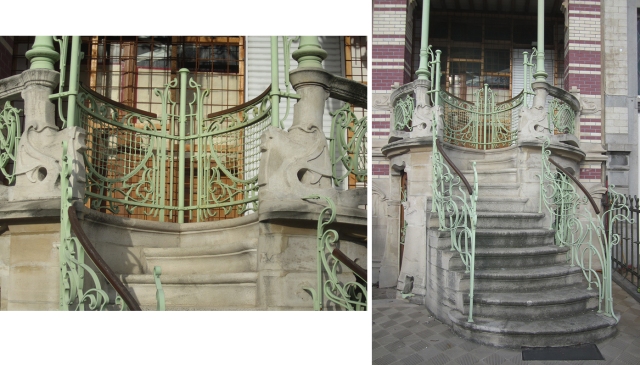
Details of lacey floral-motifs in iron
Gustave Strauven, designed this famous house for the painter Georges de Saint-Cyr and it was one of Gustave Strauven’s most important buildings. He cleverly juxtaposed various materials (brick, iron, stone, wood, glass) linking them with a crazy organic style full of movement. It is quite clear that the architect liked to utilise new technologies and experiment with different materials.
Some of my favourite details: the linking/bolting together of the iron work (see slide show images above), and the metal and stone balconies with hidden stone engraving on the underside of the balconies which almost look like a shadow of the metalwork (seen when looking up from underneath – see right hand picture below).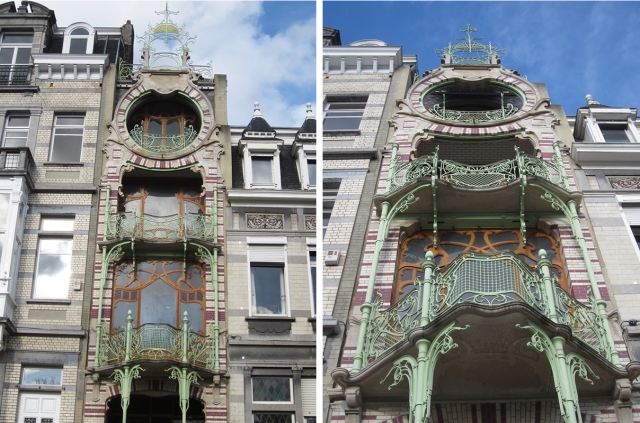 Unfortunately this incredible building has been falling into disrepair for years as not all old buildings with historical significance are protected in Belgium. Thankfully some repair works started to be made on it in 2013.
Unfortunately this incredible building has been falling into disrepair for years as not all old buildings with historical significance are protected in Belgium. Thankfully some repair works started to be made on it in 2013.
Maison Cauchie – Cauchie House – built by Paul Cauchie in 1905 is located in front of the Parc du Cinquantenaire.

‘Scraffiti’/’Sgraffito’ facade – colour drawing into cement. Applying colour, line and texture in the same way that sgraffito is used on clay. The exquisite allegorical drawings on this building are one of the elements which has led it to being viewed as one of the most important masterpieces of Art Nouveau in Brussels. Paul Cauchie specialised in designing sgraffiti for architecture, and was decorator more than architect. He created this home for his wife and himself as a huge advertisement to sell his work and services as a decorator and architect and his wife skills as a teacher. Cauchie and his wife furnished the house with fine art objects, paintings and furniture. The lettering above the door reflects the whole of the building, ‘Par Nous Pour Nous’ ‘By Us – For Us’.
Some of the metalwork here (above and below) demonstrates a more art-deco style.

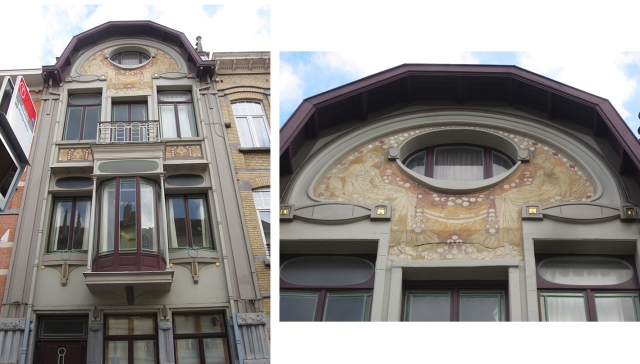
I’m not sure of the name of the building above. It is not as flamboyant as some of the others but is nonetheless equally stunning and powerful.
Below is Maison Ciamberlani built in 1897 by Paul Hankar for the painter Ciamberlani. It displays a great combination of geometry and organic Art Nouveau form. Again Scrafitti envelopes most of the building’s facade. Paul Hankar the son of a stonemason, was a furniture designer as well as architect and innovator of Art Nouveau style.
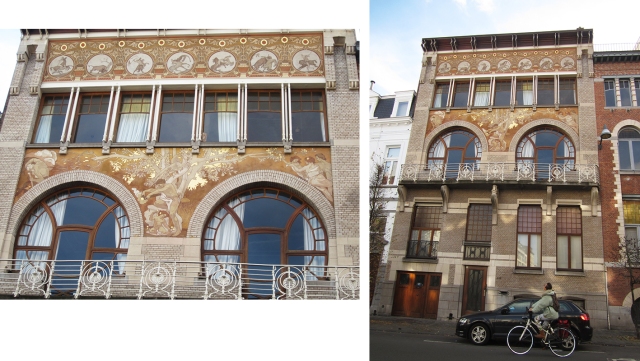

Maison Ciamberlani is located on the same street Rue Defaqz as Maison Hankar (Paul Hankar’s own house) which was his first major architectural project completed in 1893. There are a cluster of great Art Nouveau buildings in this area of St Gilles and I was fortunate to be staying close by to them.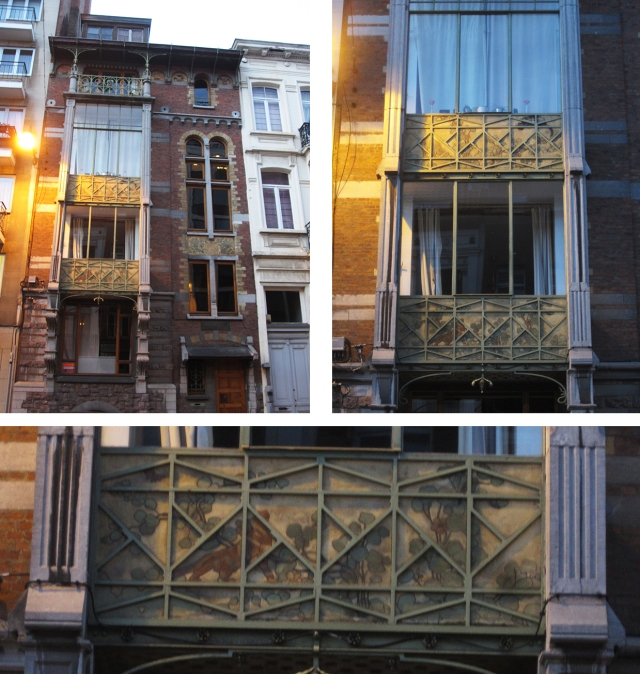
I love the geometric metalwork on the balconies, it reminds me of some old Japanese designs and furniture – particularly wooden lattice work that frames paper screens (room dividers) and shoji (traditional windows). Maison Hankar along with Hotel Tassel by Victor Horta are considered the very first two houses built in Art Nouveau style. Victor Horta and Paul Hanker also studied together and clearly shared similar interests and influences. Hotel Tassel is located in St Gilles a couple of streets from Maison Hankar.
Hotel Tassel – Victor Horta, 1893-94
Beautiful iron and stone work.
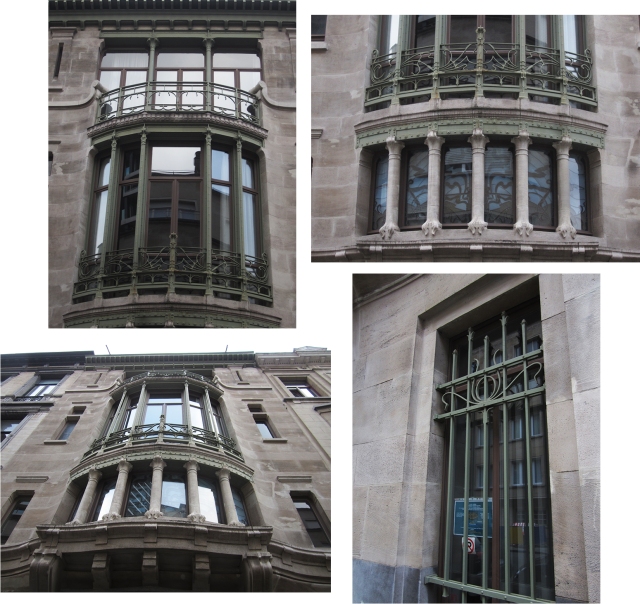
This building was built for the Belgian scientist Edmond Tassel. Victor Horta was breaking new ground in at the time through his use of iron and exposed rivets, alongside stone and glass, in domestic architecture. Some of the pillars of the building are even made from iron rather than stone. In the early 1900’s metal used in architecture was considered extremely modern.
 Victor Horta’s most well known building is probably, Horta House (his former home and studio) built between 1898-1901. It is now the Horta Museum.
Victor Horta’s most well known building is probably, Horta House (his former home and studio) built between 1898-1901. It is now the Horta Museum.
The interior of the museum is astonishing. Unfortunately it’s not possible to take photos inside. The way light is harnessed in the building, particularly through a skylight above the most incredible staircase and railings make it a unique and exceptional space to experience.
Abstract curves, geometry and motifs entwine the museums’s architecture, interior design, and furniture (which all exhibit fine craftsmanship).
The exquisite cabinetry also includes finer details such as fixtures and fittings, for example door handles. A cabinet in one of the rooms displays a set of models of various handle designs and moulds of the handles in plaster. Most of these handles were cast in metal.

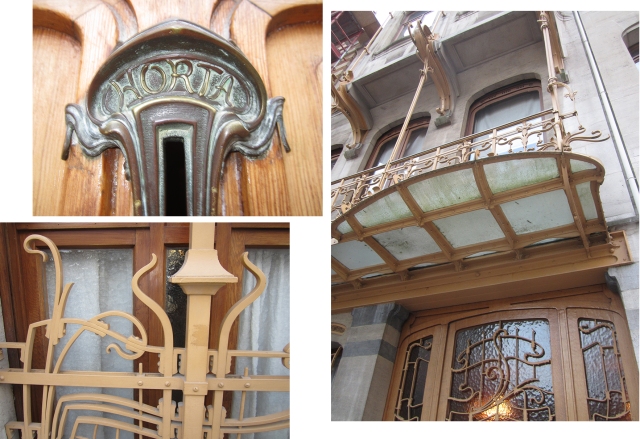
I’ve got a few more Art Nouveau architecture in Brussels images to share in my next blog post…
